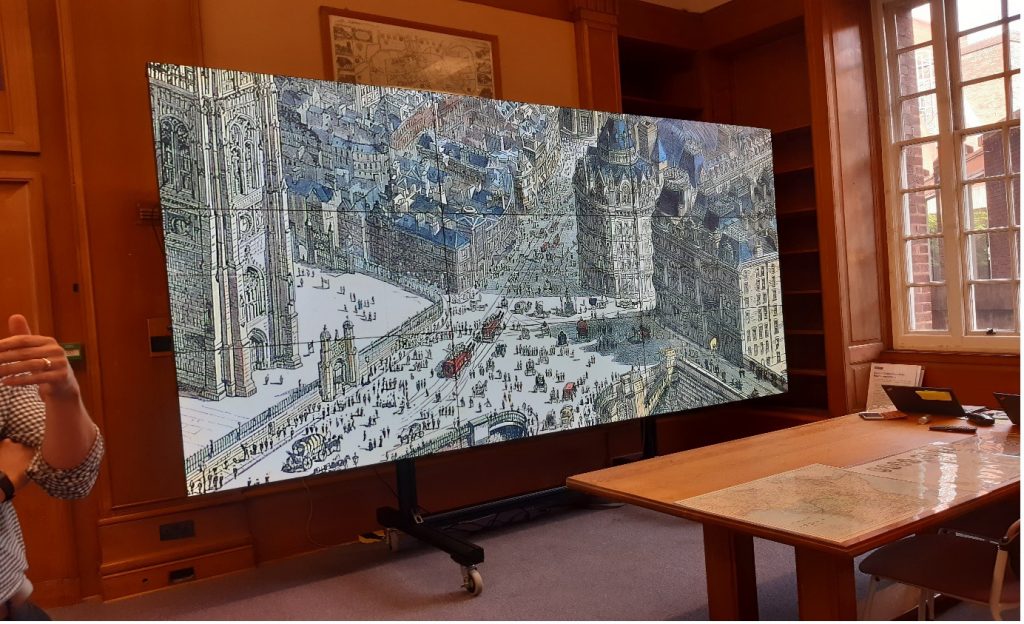
Exploring new technologies to enhance student learning: The Unique UoM PGCE offer
PGCE Historian Anna Bagnall explores the potential of some amazing new technology with the help of the UoM Special Collections team, and takes a look into Special Collections from a trainee teacher’s perspective Donna Sherman of the UoM Special Collections team gives a demonstration of the amazing potential of the new equipment, which allows teachers and students to overlay historic maps onto modern maps of Manchester
Donna Sherman of the UoM Special Collections team gives a demonstration of the amazing potential of the new equipment, which allows teachers and students to overlay historic maps onto modern maps of Manchester
Anna Bagnall, PGCE History trainee
As PGCE Historians at the University of Manchester we have a vast collection of amazing resources at our fingertips and Special Collections are a gateway into the kind of ‘curiosity- inducing’ History that was missing from many of our own educations. During our trip to the Map Room at the Main Library, Donna Sherman (Special Collections Librarian – Map Collections) and Adam Cooke [Widening Participation Co-ordinator] showed us a range of diverse maps from as far back as the 16th century, including a fascinating depiction of the world through the eyes of famous explorer Amerigo Vespucci. Fun fact: The ‘land of Amerigo’ that Vespucci sighted in 1497 became known, in time, as the ‘land of America’.

PGCE Historians explore the world as interpreted through Amerigo Vespucci’s map of 1497
We were reminded of the importance of engaging with physical sources and the excitement and curiosity that they can generate. Maps also have much academic benefit as records of historical importance, telling us about the political climate and motivations of the time, as well as how different cultures throughout history have viewed the world. The highlight of the visit was working with the ‘zoom lens’, an incredibly powerful visualizer that is able to pick up and project detail in documents that are sometimes impossible to detect with the naked eye. Incredible, granular level detail from maps and other sources was projected onto a huge screen. The picture below demonstrates the incredible skill of an artist whose ‘3D’ map of Manchester in 1893 contains almost an almost unimaginable level of detail. The ‘real’ size of the segment in question was literally centimetres!

The high-resolution bank of screens display a small section of the 1893 map of Manchester, revealing incredible detail
Such technology offers so much potential and is one, among many compelling reasons to study for a PGCE at a major university. The technology in question can also connect to Zoom, offering the possibility of remote use with schools and partner institutions who might struggle to engage with it in person.
We were also introduced to a software whereby historical maps can be placed on top of modern maps to allow pupils and educators to explore the differences between then and now; showing change and continuity in the evolution of the great city of Manchester in a unique way. We’re now busy planning a series of lessons focused on how maps can show us how Manchester developed over the past 200 years.
Although the focus of our visit was the Map Room, we were made aware of a huge range of source that are also kept in Special Collections. Stone tablets to emails, medieval muniments to musical manuscripts, rare tomes to twentieth-century photography, are all ripe for pedagogical harvest! We’re really looking forward to further work with Special Collections at the John Rylands library later this year, when we’ll be working with the Guardian Archives and seeing how they can illuminate the women of Manchester and their rich histories. History of global resonance was made on these streets and the UoM Special Collections offer such great potential. If an example is required of this global importance, Karl Marx’s desk in the Chetham library shows where he and Engels worked in the 1840s and where The Condition of the Working Class in England was written.
Helping the students in our placement schools to engage with these collections is the next stage in our work. The collections are on the doorstep of many of our placement schools and can have distinct academic benefits, as well as breaking down barriers to the perceived elitism of archival research, allowing students to see studying History at university as accessible, exciting, and alive with possibilities.





0 Comments